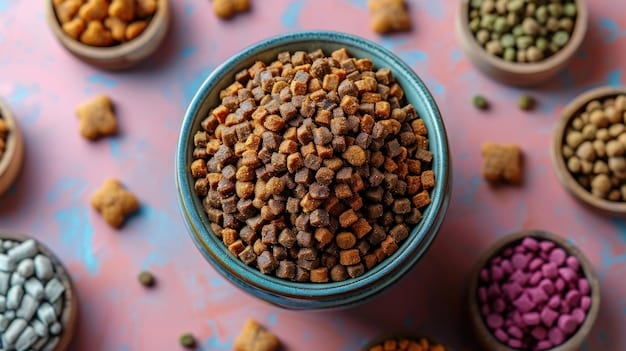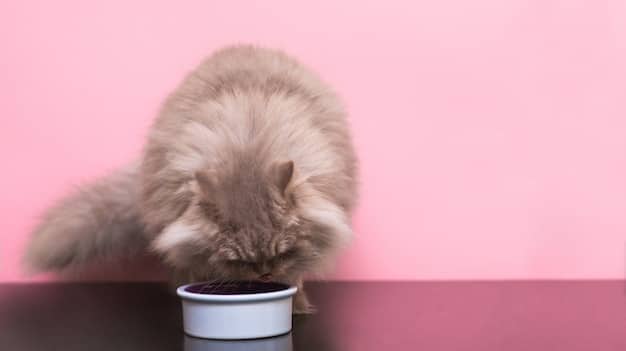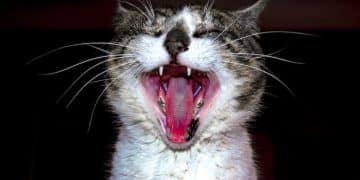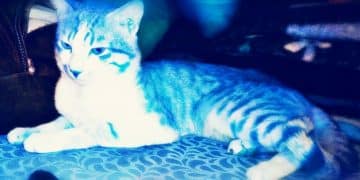Cat Food Reviews 2025: Wet vs. Dry, Grain-Free & More

Cat food reviews for 2025 reveal a growing trend towards specialized diets including wet, dry, and grain-free options, tailored to meet the specific health needs and preferences of cats, ensuring optimal nutrition and well-being.
Navigating the world of cat food reviews: wet vs. dry, grain-free, and more in 2025 can feel overwhelming. With so many options available, how do you ensure you’re providing the best nutrition for your feline friend? Let’s dive into the latest trends and recommendations to help you make informed choices.
Understanding the Basics of Cat Nutrition
Before diving into specific types of cat food, it’s essential to understand the fundamental nutritional needs of cats. As obligate carnivores, cats require a diet rich in animal protein, moderate in fats, and low in carbohydrates. Ensuring these needs are met is critical for their overall health and well-being.
Essential Nutrients for Cats
Cats require specific nutrients to thrive. These include taurine, arginine, and certain vitamins and minerals. Deficiencies in these areas can lead to serious health issues.
- Taurine: An essential amino acid for heart and eye health.
- Arginine: Necessary for proper liver function and waste removal.
- Vitamins & Minerals: Including Vitamin A, Vitamin D, and calcium, crucial for various bodily functions.
AAFCO Standards
When selecting cat food, look for products that meet the standards set by the Association of American Feed Control Officials (AAFCO). This ensures the food provides complete and balanced nutrition.
Choosing cat food involves understanding feline nutritional needs and looking for AAFCO approval. Prioritizing protein-rich, nutritionally complete food ensures your cat’s health and happiness.

Wet Cat Food: Benefits and Considerations
Wet cat food, also known as canned food, is a popular choice among cat owners. Its high moisture content can be particularly beneficial for cats that don’t drink enough water. Understanding its advantages and disadvantages is vital for making the right choice.
Hydration Benefits
One of the primary advantages of wet cat food is its high moisture content, typically around 70-80%. This can help prevent dehydration, especially important for cats prone to urinary tract issues.
Texture and Palatability
Many cats find wet food more palatable due to its aroma and texture. This can be particularly useful for picky eaters or older cats with diminished senses of smell and taste.
- Variety of Textures: Available in pate, chunks, and shredded forms.
- Stronger Aroma: Stimulates appetite in finicky cats.
- Easier to Eat: Softer texture is gentle on sensitive mouths.
Potential Drawbacks
Despite its benefits, wet cat food also has some downsides. It’s generally more expensive than dry food and has a shorter shelf life once opened.
Wet cat food is an excellent option for ensuring hydration and appealing to picky eaters, but it’s essential to consider the higher cost and shorter shelf life when making your decision.
Dry Cat Food: Convenience and Dental Health
Dry cat food, or kibble, is a convenient and cost-effective option for many cat owners. Its crunchy texture can also contribute to dental health. Knowing when and why to opt for dry food can enhance your cat’s diet.
Convenience and Cost-Effectiveness
Dry cat food is easy to store, measure, and serve. It also tends to be more affordable than wet food, making it a budget-friendly option for multi-cat households.
Dental Benefits
The abrasive texture of dry kibble can help reduce tartar and plaque buildup, promoting better dental hygiene. Some brands even include additives to further support oral health.
Considerations
While convenient, dry cat food typically has lower moisture content than wet food. It’s crucial to ensure your cat has access to plenty of fresh water throughout the day.
Dry cat food offers convenience and dental benefits, but it’s important to monitor your cat’s hydration levels and choose a high-quality formulation to ensure their nutritional needs are met.

Grain-Free Cat Food: Is It Necessary?
Grain-free cat food has gained popularity in recent years. It’s important to understand what grain-free means and whether it’s truly beneficial for your cat. Knowing the context behind this trend aids in making the correct dietary choices.
Understanding Grain-Free Diets
Grain-free cat food excludes common grains such as corn, wheat, and soy. Instead, it uses alternative carbohydrate sources like potatoes, peas, and tapioca.
Potential Benefits
Some cats may benefit from a grain-free diet, particularly those with diagnosed grain allergies or sensitivities. However, true grain allergies are relatively rare in cats.
- Manage Allergies: Reduces exposure to common allergens.
- Improved Digestion: Some cats digest grain-free formulas more easily.
- Addressing Sensitivities: Can resolve issues related to grain intolerance.
Dispelling Myths
It’s a common misconception that grains are inherently bad for cats. In reality, most cats can digest grains without issue. The key is to choose a balanced diet that meets your cat’s nutritional needs, regardless of whether it contains grains.
Grain-free cat food can be beneficial for cats with specific allergies or sensitivities, but it’s not a necessary choice for all cats. A balanced, nutritionally complete diet is paramount.
Reading and Interpreting Cat Food Labels
Understanding how to read and interpret cat food labels is crucial for making informed decisions. Labels provide valuable information about ingredients, nutritional content, and feeding guidelines. Being label-literate ensures your cat’s diet is optimal.
Key Components of a Cat Food Label
Familiarize yourself with the essential elements of a cat food label, including the ingredient list, guaranteed analysis, and feeding instructions.
Ingredient List
Ingredients are listed in descending order by weight. Look for a named meat source (e.g., chicken, turkey, salmon) as the primary ingredient.
Guaranteed Analysis
The guaranteed analysis provides information on the minimum percentage of crude protein and crude fat, as well as the maximum percentage of crude fiber and moisture. These values help ensure your cat receives adequate nutrition.
Interpreting food labels accurately can vastly upgrade the choices you make for your cat’s diet. Concentrating on element specifics ensures a healthier and well-balanced regime.
Transitioning Your Cat to a New Food
When switching your cat to a new food, it’s essential to do so gradually to avoid digestive upset. A slow transition allows your cat’s digestive system to adjust, preventing issues like vomiting or diarrhea. Proper transitioning is crucial.
The Gradual Approach
Start by mixing a small amount of the new food with your cat’s current food. Gradually increase the proportion of the new food over a period of 7-10 days.
Monitoring Your Cat’s Response
Keep a close eye on your cat’s appetite, energy levels, and stool consistency during the transition. If you notice any adverse reactions, slow down the process or consult with your veterinarian.
- Day 1-3: Mix 25% new food with 75% old food.
- Day 4-6: Mix 50% new food with 50% old food.
- Day 7-9: Mix 75% new food with 25% old food.
- Day 10: Transition completely to the new food.
Transitioning food requires patience and vigilance. By gradually introducing new food while monitoring your cat, you ensure they adjust without discomfort and maintain their health.
Special Dietary Considerations for Cats in 2025
In 2025, special dietary needs are increasingly addressed with tailored cat food options. From weight management to senior care, understanding these specific considerations helps in providing optimal nutrition for every stage of your cat’s life.
Weight Management
Overweight cats may benefit from a diet lower in calories and higher in fiber to promote satiety. Look for formulas specifically designed for weight management.
Senior Cat Diets
Older cats often require food that is easier to digest and contains added nutrients to support joint health and cognitive function. Senior-specific diets are formulated to meet these needs effectively.
Addressing special dietary needs enhances the health and quality of life for cats at different stages. Considering tailored solutions makes nutrition simpler and much more effective.
| Key Point | Brief Description |
|---|---|
| 💧 Hydration with Wet Food | Wet food’s moisture helps cats stay hydrated and prevents urinary issues. |
| 🦷 Dental Benefits of Dry Food | Dry kibble’s texture reduces tartar and plaque buildup for better dental health. |
| 🌾 Grain-Free Considerations | Grain-free diets benefit cats with allergies but aren’t necessary for all. |
| ⚖️ Gradual Food Transitions | Introduce new food slowly to avoid digestive upset over 7-10 days. |
Frequently Asked Questions
▼
Wet cat food is higher in moisture, which helps with hydration, and often more palatable. Dry cat food is more cost-effective, convenient to store, and offers dental benefits through its abrasive texture, helping reduce plaque buildup.
▼
No, grain-free cat food is not necessarily better for all cats. It’s primarily beneficial for cats with grain allergies or sensitivities. Most cats can digest grains without any issues, provided they are part of a balanced diet.
▼
To transition your cat to a new food, mix a small amount of the new food with their current food over 7-10 days. Gradually increase the proportion of the new food while monitoring for any digestive issues, such as vomiting or diarrhea.
▼
When reading a cat food label, look for a named meat source as the first ingredient, check the guaranteed analysis for protein and fat percentages, and ensure the food meets AAFCO standards for complete and balanced nutrition.
▼
Yes, senior cats often require food that is easier to digest, with added nutrients to support joint health and cognitive function. Senior-specific diets are formulated to cater to these needs, ensuring older cats receive appropriate nutrition.
Conclusion
Choosing the right cat food involves understanding your cat’s individual needs, reading labels carefully, and transitioning food gradually. By considering wet, dry, and grain-free options, and staying informed about the latest nutritional recommendations, you can ensure your feline companion enjoys a healthy and fulfilling life.





